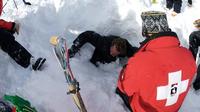-
Platform for operating systems would outwit cyber criminals
As smartphone use surges, consumers are just beginning to realize their devices are not quite as secure as they thought. A Swedish research team is working on a way to secure mobile operating systems so that consumers can be confident that their data is protected.
-
-
App helps save people trapped by avalanche

For the person buried under the weight of an avalanche, each minute is precious. A person saved from the snow mass within fifteen minutes has a 90 percent chance of survival. After forty-five minutes that chance has diminished considerably. Researchers develop an app that makes it possible for skiers with smartphones to find people buried in the snow.
-
-
Too much too young? Teaching children about violent extremism
Dealing with the rise of homegrown terrorism has prompted governments to take novel approaches in combating such threats. The U.K. government, for example, has recently pushed for schools to teach children as young as four about the dangers of violent extremism. One counter-radicalization strategy adopted by the U.K. government is Prevent, which has been used effectively in British secondary schools. Prevent has in the past been viewed with suspicion, however, particularly by British Muslim communities, as Prevent funding has previously been tied directly to the number of Muslim schools in an area. What Australia can learn from the British example is ensuring that certain communities do not feel alienated. Instead, any attempts at education should focus on the problem of radicalization as a whole.
-
-
Virtual lab for nuclear waste repository research
A nuclear waste repository must seal in radioactive waste safely for one million years. Researchers currently have to study repositories and their processes in real underground laboratories, but a virtual underground laboratory will soon simplify their work.
-
-
Flood risk in Europe could double by 2050
Losses from extreme floods in Europe could more than double by 2050 because of climate change and socioeconomic development. Floods in the European Union averaged 4.9 billion euros a year from 2000 to 2012. These average losses could increase to 23.5 billion euros by 2050. In addition, large events such as the 2013 European floods are likely to increase in frequency from an average of once every sixteen years to a probability of once every ten years by 2050. Understanding the risk posed by large-scale floods is of growing importance and will be a key for managing climate adaptation.
-
-
What use are apps when your web infrastructure is underwater?
This winter has seen unprecedented high winds and flooding resulting in widespread and in some cases, long-lasting power outages in the United Kingdom, particularly in the west of England. Time and time again, companies have advised their customers to go online to check their Web sites for the latest information. Some organizations have even created apps specifically designed to assist flood victims; others have established Facebook self-help groups. There is a fundamental problem here: There are two primary ways in which we gain access to the Web, via a landline and using a mobile connection. Within our homes the landline connects to a wireless router and also, for a lot of homes, a cordless telephone, both of which need electrical power to work. So, when the lights go out, your router and cordless phones are useless. The result is that at times of crisis, the customers in most need are often the ones with no access.
-
-
People want to save water, but do not know how
Many Americans are confused about the best ways to conserve water and have a slippery grasp on how much water different activities use, according to a national online survey. Experts say the best strategy for conserving water is to focus on efficiency improvements such as replacing toilets and retrofitting washing machines. The largest group of the participants, however, nearly 43 percent, cited taking shorter showers, which does save water but may not be the most effective action.
-
-
Real-time forecast of Hurricane Sandy accurately predicted storm’s track, intensity
A real-time hurricane analysis and prediction system that effectively incorporates airborne Doppler radar information may accurately track the path, intensity, and wind force in a hurricane. This system also can identify the sources of forecast uncertainty.
-
-
Volcanic eruptions explain recent warming hiatus

Volcanic eruptions in the early part of the twenty-first century have cooled the planet, according to a study led by Lawrence Livermore National Laboratory. This cooling has partly offset the warming produced by greenhouse gases, explaining why, despite continuing increases in atmospheric levels of greenhouse gases, and in the total heat content of the ocean, global-mean temperatures at the surface of the planet and in the troposphere (the lowest portion of the Earth’s atmosphere) have shown relatively little warming since 1998. Scientists note that human-induced – that is, greenhouse gasses emissions-related — change typically causes the troposphere to warm and the stratosphere to cool. In contrast, large volcanic eruptions cool the troposphere and warm the stratosphere.
-
-
University of Texas at San Antonio ranked top U.S. cybersecurity school

The University of Texas at San Antonio (UTSA) ranks as the top school for cybersecurity courses and degree programs according to a Hewlett-Packard (HP)-sponsored surveyof 1,958 certified IT security professionals. The schools undergraduate and graduate programs received top marks for academic excellence and practical relevance.
-
-
Unsupervised robotic construction crew to build flood defenses
On the plains of Namibia, millions of tiny termites are building a mound of soil — an 8-foot-tall “lung” for their underground nest. They do so without a supervisor, foreman, or CEO to tell them what to do. During a year of construction, many termites will live and die, wind and rain will erode the structure, and yet the colony’s life-sustaining project will continue. Harvard researchers, inspired by the termites’ resilience and collective intelligence, have created an autonomous robotic construction crew. The system needs no supervisor, no eye in the sky, and no communication: just simple robots — any number of robots — that cooperate by modifying their environment. In the future, similar robots could lay sandbags in advance of a flood, or perform simple construction tasks on Mars.
-
-
Robots help Border Patrol navigate smugglers’ tunnels
The U.S. Border Patrol is using remote- controlled robots to navigate tunnels used by drug cartels and smugglers to import drugs, weapons, and people from Mexico into the United States.The robots are used as the first eyes on places deemed too dangerous for humans to explore.
-
-
Remote explosives detection may see the end of full-body scanners
Standing in a full-body scanner at an airport is not fun, and the process adds time and stress to a journey. It also raises privacy concerns. Researchers now report a more precise and direct method for using terahertz (THz) technology to detect explosives from greater distances. The advance could ultimately lead to detectors that survey a wider area of an airport without the need for full-body scanners.
-
-
Washington State offers college financial aid to children of undocumented immigrants
Governor Jay Inslee of Washington State yesterday signed legislation which will offer college financial aid to students brought into the United States illegally by their parents. California, Illinois, Texas, and New Mexico have passed similar legislations. The measure represents a shift in the position of State Senate Republicans: last year, the GOP-controlled Senate blocked a similar measure,called the Dream Act of Washington State, but earlier this month the Senate passed its own version of the bill, which the the governor, a Democrat, signed.
-
-
Collegiate cyber defense competition advances to regional finals
Seven members of the University of Maine Cyber Defense Team will compete at the annual Northeast Collegiate Cyber Defense Competition at the University of New Hampshire in March. The team was one of nine out of a pool of fourteen schools that qualified for the regional competition. The competition simulates security operations for a small company. Teams must quickly familiarize themselves with network systems and software before beginning to defend against attacks while also providing customer service to users.
-
More headlines
The long view
Autonomous Vehicle Technology Vulnerable to Road Object Spoofing and Vanishing Attacks
Researchers have demonstrated the potentially hazardous vulnerabilities associated with the technology called LiDAR, or Light Detection and Ranging, many autonomous vehicles use to navigate streets, roads and highways. The researchers have shown how to use lasers to fool LiDAR into “seeing” objects that are not present and missing those that are – deficiencies that can cause unwarranted and unsafe braking or collisions.
Tantalizing Method to Study Cyberdeterrence
Tantalus is unlike most war games because it is experimental instead of experiential — the immersive game differs by overlapping scientific rigor and quantitative assessment methods with the experimental sciences, and experimental war gaming provides insightful data for real-world cyberattacks.
Prototype Self-Service Screening System Unveiled
TSA and DHS S&T unveiled a prototype checkpoint technology, the self-service screening system, at Harry Reid International Airport (LAS) in Las Vegas, NV. The aim is to provide a near self-sufficient passenger screening process while enabling passengers to directly receive on-person alarm information and allow for the passenger self-resolution of those alarms.
Falling Space Debris: How High Is the Risk I'll Get Hit?
An International Space Station battery fell back to Earth and, luckily, splashed down harmlessly in the Atlantic. Should we have worried? Space debris reenters our atmosphere every week.
Testing Cutting-Edge Counter-Drone Technology
Drones have many positive applications, bad actors can use them for nefarious purposes. Two recent field demonstrations brought government, academia, and industry together to evaluate innovative counter-unmanned aircraft systems.
Strengthening the Grid’s ‘Backbone’ with Hydropower
Argonne-led studies investigate how hydropower could help add more clean energy to the grid, how it generates value as grids add more renewable energy, and how liner technology can improve hydropower efficiency.
